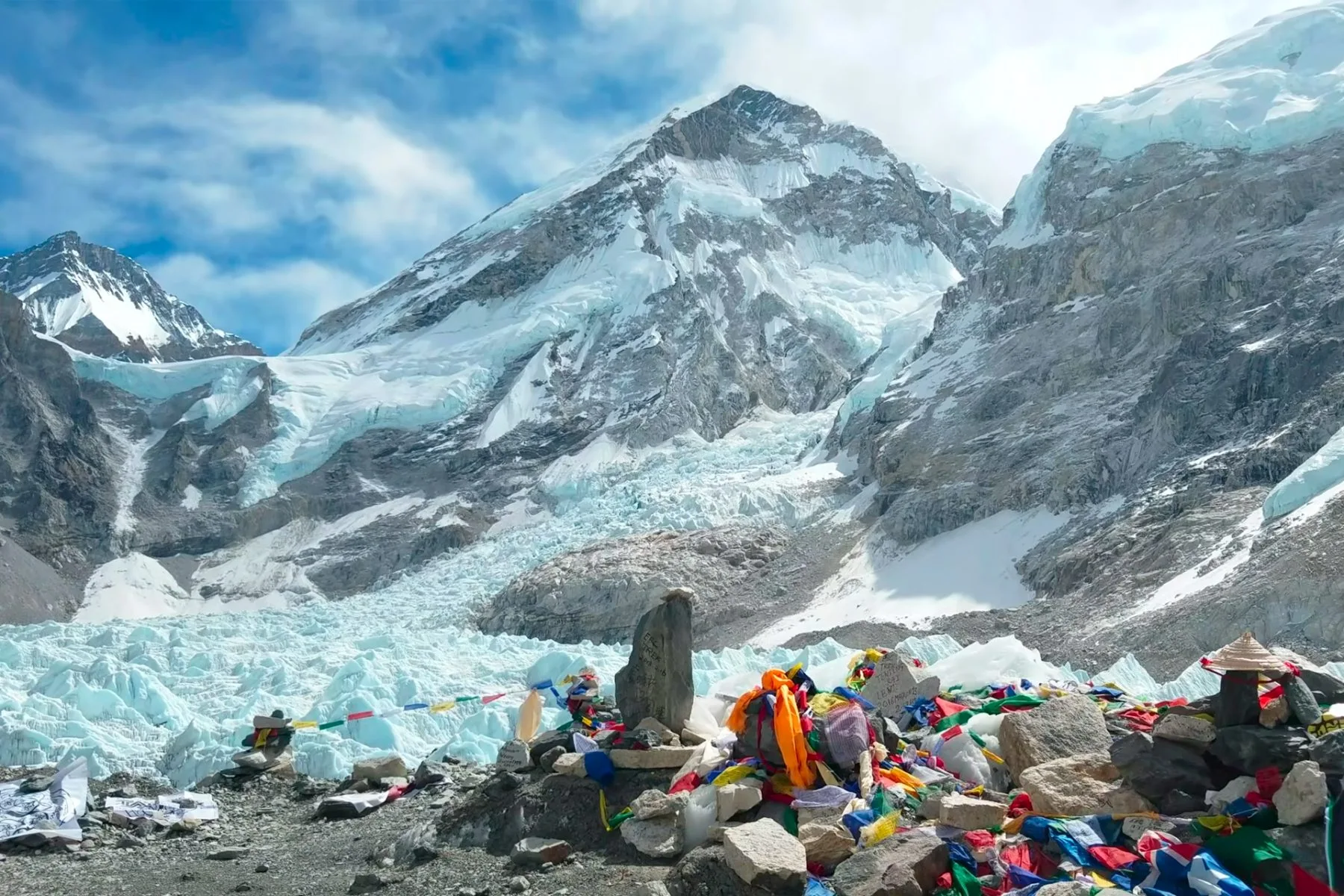The Annapurna Base Camp Helicopter Tour is a thrilling adventure. It allows you to take in the breathtaking beauty of the Annapurna region from the air. This tour is ideal for those who want to experience the Annapurna Base Camp trek but have limited time or physical abilities. It is the easiest and shortest way to reach Annapurna base camp from Kathmandu.
This helicopter tour covers the eight-day trek to the Annapurna base camp in one day. Enjoy breathtaking bird’s-eye views of the entire grandeur of the Annapurna region. The magnificent view of some of the highest mountains in the world will take your breath away. This ABC helicopter tour has no age limit.
Attractions of the Annapurna Base Camp Helicopter Tour
View of the mountains:
The Annapurna Heli Tour offers a view of majestic snow-capped peaks. You will have the opportunity to witness Annapurna I, Machhapuchhre, and Dhaulagiri mountains. A bird’s-eye view allows you to appreciate the grandeur of these mountains.
Convenient Access:
This trip provides convenient access to Annapurna base camp in a short time. It takes several days to reach the base camp through traditional trekking routes. A helicopter tour allows you to reach the Annapurna base camp in a few hours. This is especially attractive for those with limited time or physical limitations.
Annapurna Sanctuary:
The Annapurna Helicopter Tour takes you deep into the Annapurna Sanctuary. It offers a unique and intimate experience of the landscape of the surrounding peaks and glacier-covered terrain.
Diverse landscape:
It is a scenic flight over diverse landscapes. The helicopter takes you over terraced fields, rhododendron forests, and traditional Nepalese villages. The contrast between the greenery and the snow-capped peaks creates a stunning visual scene.
Landing at Annapurna Base Camp:
The highlight of this tour is the landing at Annapurna Base Camp. This creates an opportunity for you to step into the high-altitude terrain, enjoy the views, and take memorable photos. The experience of standing amidst the towering mountains is truly exciting and amazing.
Cultural Insights:
The helicopter will take you over the various traditional villages of the Annapurna region. You can get a glimpse of the unique culture and lifestyle of the people in this region. It adds a cultural dimension to the adventure.
Memorable Experience:
The tour promises an unforgettable and awe-inspiring experience. It is a combination of adventure, natural beauty, and cultural immersion in a short period. This tour is an easy and great option for those looking for a unique way to explore the Himalayas.
Photography Opportunities:
This tour offers excellent opportunities for photography. It allows you to capture the beauty of the Himalayas from a unique location. Changing lighting conditions and dynamic landscapes create stunning photographic moments.
Duration
The duration of the Annapurna Base Camp helicopter tour may vary. The duration may vary depending on factors such as the specific route, weather conditions, and type of helicopter. However, here is a general overview regarding the duration:
Before starting the trip, participants usually attend a pre-flight briefing. In this session, participants are briefed on security procedures and the overall itinerary. The briefing ensures that you are aware of the dos and don’ts of the trip. The pre-flight briefing takes 15 to 30 minutes. Usually, the starting point of a flight to Annapurna base camp is Kathmandu or Pokhara. It takes about 1 to 1.5 hours from Kathmandu. If you take a flight from Pokhara, it may take 30 minutes to 1 hour.
After reaching the Annapurna base camp, the helicopter lands. You can enjoy panoramic views of the surrounding mountains, including Annapurna and Machhapuchhare. The duration of ground time can vary, but it is usually 30 minutes. After spending some time at the Annapurna base camp, the helicopter returns by the same route. Again, return flight duration depends on weather conditions and specific route factors. Returning to Kathmandu takes 1 hour to 1.5 hours, while Pokhara takes 30 minutes to 1 hour.
After returning to the starting point, there may be some post-flight activities or a debriefing session. Its duration is 15 to 30 minutes. This session provides an opportunity to share your experiences and ask any remaining questions. Overall, you can complete the Annapurna helicopter tour in 4 hours.
Difficulty of Annapurna base camp heli tour
Reaching the Annapurna base camp requires a week of strenuous trekking. However, the helicopter tour allows one to visit the ABC in a short time without any physical exertion. A helicopter tour is a faster and less physically demanding option. The advantage of this tour is its accessibility for people with different fitness levels and limited time.
By using a helicopter, you can avoid the difficult trekking routes and challenges associated with high-altitude trekking. However, it is important to consider that altitude sickness may be a risk. The altitude of the Annapurna base camp is 4,130 meters (13,550 ft), and there is still a possibility of altitude sickness.
Yes, helicopter tours are not physically demanding, but it is important to be aware of potential altitude-related issues. So, make sure you have good health to go above 4000 meters. If you have any concerns, it is advisable to consult a healthcare professional before traveling. Good preparation and proper precautions help make your trip easy and enjoyable.
Itinerary for Annapurna base camp helicopter tour
If you are starting your journey from Kathmandu, you will reach the helipad of the airport at 6 a.m. At 6:30 a.m., there will be a briefing on the itinerary, safety precautions, and helicopter procedures. At 7:00 am, the helicopter will take off for the scenic Annapurna base camp. This trip offers you an amazing opportunity to enjoy the breathtaking views of the mountain range.
Around 9:00 AM, the helicopter will land at the base camp. Explore the Annapurna base camp and capture the stunning surroundings. Return to the helicopter around 11 a.m. and prepare for the return flight. Around noon, you will land in Kathmandu.
the rest of the day, you can alternatively explore Kathmandu or relax at your hotel. If you fly from Pokhara, the schedule will be slightly different. Note that the above itinerary is a general guideline. The trip may also change based on real-time tour operators, weather conditions, and other factors.
Safety Guidelines
It is important to follow some safety guidelines to ensure a safe and enjoyable experience. Choosing a reputable tour operator is important for a safe trip. It is also important to look for experienced pilots with good safety records. Read reviews and testimonials to ensure the company’s credibility.
Weather can change rapidly in mountainous areas, so monitor weather conditions closely. Flights may be delayed or canceled due to bad weather. Follow the pilot’s and tour operator’s instructions regarding weather-related decisions. Pay attention to the safety briefing provided by the pilot or tour operator before the flight. The briefing covers safety procedures, emergency protocols, and important information about the flight.
Ensure the helicopter company adheres to proper maintenance and safety standards. Well-maintained helicopters are critical to safe flight. There are weight limits when taking a high-altitude helicopter tour. It is important to follow the passenger and baggage weight limits to ensure a safe and balanced flight.
Familiarize yourself with the emergency procedures outlined by the pilot during the trip. This includes the location of emergency exits, communication devices, and safety equipment. Be prepared for possible altitude sickness prevention. If you have problems with altitude sickness, consider acclimatizing before flying. Stay hydrated and follow guidelines for acclimatization to reduce the risk of altitude-related problems.
The pilot will select a suitable landing site at the base camp. Follow the pilot’s instructions during helicopter landing and takeoff. Pay attention to the safety guidelines at the destination. Make sure you have travel insurance for a safe trip. Travel insurance covers possible medical emergencies during helicopter tours.
These guidelines are general recommendations. It is important to follow the specific instructions provided by the helicopter tour operator. Always prioritize safety on helicopter tours. If you have any concerns, you can discuss them with the tour operator before the flight.
Read Also: How difficult is Everest Base Camp Trek?
Cost of Annapurna base camp heli tour
The cost of the Annapurna base camp helicopter tour depends on many factors. The cost may vary due to the tour operator, tour duration, additional services, number of passengers, etc. On average, the cost per person ranges from $500 to $1000. Costs may also change due to fluctuating fuel prices and other factors. Prices may also vary due to helicopter availability, seasonal variations, and helicopter demand. However, the awe-inspiring view of the Himalayas from the sky is priceless.
The best time for Annapurna helicopter tour
The best times for the Annapurna base camp helicopter tour are in spring and autumn. Spring includes the months of March to May, and autumn includes September to November. During these times, there are stable weather conditions and clear skies. Clear weather provides optimal visibility to enjoy stunning landscapes.
Spring is a popular time for helicopter tours in Nepal. The weather in spring is usually clear, and the temperature is moderate. The rhododendrons are in bloom during this period, adding vibrant colors to the scenery. Another great time for the Annapurna helicopter tour is autumn. This season also brings stable weather and clear skies. The temperature is comfortable, and the visibility is excellent, which allows for breathtaking views.
During these seasons, there is less chance of encountering heavy rain or snow. However, keep in mind that the weather conditions in mountainous areas can be unpredictable. So, it is a good idea to check with tour operators for real-time updates on your tour plans.
Frequently Asked Questions
What is the duration of the helicopter tour of the Annapurna base camp?
The duration may vary depending on the specific tour package, route, and operator. Usually, it takes about 4 to 5 hours.
Are there any weight restrictions on helicopter tours?
Yes, most helicopter tours have weight restrictions for safety reasons. It is essential to inquire about these restrictions at the time of booking.
Can I join other groups for the Annapurna Helicopter Tour?
Yes, you can join a group if you are traveling alone. Joining a group helps share the cost of the tour.
Can I take photographs during the helicopter tour?
Absolutely! Photography enthusiasts will be delighted by the numerous photo opportunities during the tour. Make sure to bring your camera and extra batteries to capture the breathtaking views.
Will oxygen be provided during the flight?
The helicopters used for the Annapurna Base Camp Helicopter Tour are pressurized and equipped with oxygen masks for emergencies. However, oxygen supplementation is generally not required for this tour, as the flight duration is relatively short.
Is there a weight limit for passengers?
Yes, there is a weight limit for passengers due to safety reasons. The exact limit may vary depending on the helicopter model and the number of passengers on the tour. It is important to provide accurate information about your weight during the booking process.
Conclusion
The Annapurna Base Camp Helicopter Tour is a remarkable adventure that offers a unique perspective of the majestic Himalayas. Whether you are short on time or prefer a more accessible option, this tour allows you to witness the beauty of the Annapurna region without the physical demands of a traditional trek. From the breathtaking aerial views to the cultural experiences along the way, this tour promises an unforgettable journey through one of the world’s most incredible landscapes. Take to the skies and create memories that will last a lifetime.
Additionally, we offer variations on the Annapurna Base Camp Helicopter Tour. We also create custom itineraries with additional stops or extended ground time. For more information about the Annapurna helicopter tour, please feel free to contact us.
You May like: the Everest base camp helicopter tour


















